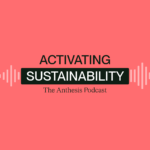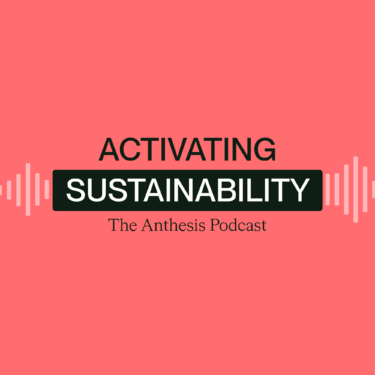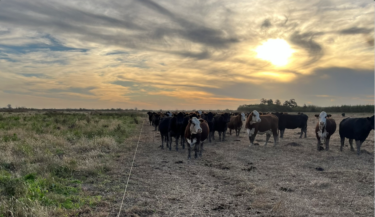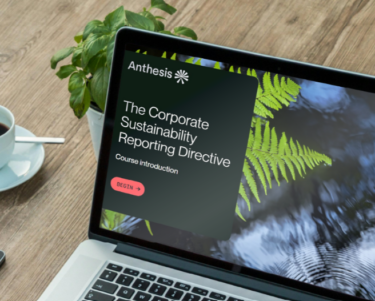
Speakers
Chris Peterson – Director, North America
Bianca Nijhof
Christopher Hakes – Associate Director, Carbon Markets
Related Topics
- Intro to Business for Nature | WBCSD + Anthesis Activator Academy
- SARA Achieves Verra Registration
- Nature Solutions
- Carbon Credits and Projects
Share this episode
In this episode of our Activating Sustainability series, our host, Chris Peterson, is joined by Bianca Nijhof and Christopher Hakes to explore the intersection of climate and nature in corporate sustainability strategies. The conversation unpacks how companies can better align carbon and nature risk assessments, invest in credits with dual benefits, and take meaningful action to build resilience and contribute to a nature-positive future.

Read the transcript
Chris Peterson: Hello and welcome to Activating Sustainability, the Anthesis podcast. I’m your host, Chris Peterson. Today we’re exploring the intersection and dual value, co-benefits of nature and carbon credits. How they can work together, and why it’s a key part of an effective strategy. As always, to help us unpack, understand, and act on these opportunities, I’m joined by some of my Anthesis Group colleagues. On this episode, we’re speaking with Bianca Niijhof, Global Lead for Nature, and Chris Hakes, Associate Director, Carbon Products and Services. Welcome to the podcast. Thanks so much for joining us.
Bianca Nijhof: Thank you for having us.
Christopher Hakes: It is a pleasure to join. Yeah, thanks Chris.
Chris Peterson: Wonderful. Well, maybe to start us off, nature is such a broad term. I wonder if maybe Bianca, you could kind of help us think about how do you actually define nature and some of the key elements that we’ll be talking about today.
Bianca Nijhof: So thanks for the ask, Chris. It’s really good to get those definitions right.
So nature is actually all the living things around us. And in some definitions, it also includes water, and it also includes soil. But, in general, I would say it’s all the living things, which you would see. The term nature is usually mixed up with the term biodiversity, whereas biodiversity is really referring to the diversity of species, the diversity in genes within those species. But it’s much more a quality thing within nature. So, whenever the biodiversity is aligned with what you would expect in that situation from the water quality around it, the soil quality around it, the type of soil ̶̶ there’s a good biodiversity, reflecting a quality actually.
Deliberately not using the term a higher biodiversity is more valuable because that’s the way it’s usually used, but that would mean actually that a tropical forest with high biodiversity is more valuable than this peatland area, which has a lower biodiversity. But both serve that purpose for that specific environment. So it’s really a biodiversity appropriate for that specific location. So nature, the living things around us, sometimes included water and soil as well. And biodiversity, really being the variety of species in and as a quality measure. Two other terms, which quite often get mixed up are actually the term nature-based solutions versus the term of natural climate solutions. And that will come later in the podcast, but especially when we connect nature with the theme of climate, nature-based solutions is actually all the solutions nature provides us with, which also have a social of a benefit to society. That can be anything from mangroves, protecting the hinterland, from being flooded to, for example, carbon capture. But that carbon capture side of things is actually, has a specific name to it and it’s natural climate solutions. Another nature-based solutions could, for example, also be sand sedimentation in front of the coast to protecting the coast again from being flooded. So, me being Dutch, that is a very much a nature-based solutions for me. And I always get confused when people who refer to natural climate solutions as being nature-based solutions. So, I think it’s important to distinguish the two.
Chris Peterson: That’s great. Thanks. And yeah I know those are coming up a lot as we go through this. And, Bianca, I know often you talk about the role nature plays in the way that we operate and we often take it for credit. I’m curious kind of if you could expand on that just briefly.
Bianca Nijhof: Yeah, thanks. Well over the years, actually, if you look back, nature has covered us actually for capturing a lot of carbon and you might’ve heard that oceans, for example, are capturing a lot of carbon as well. But now when the oceans are getting warmer, they’re able to capture less carbon. And if you look at wetlands as well, for example, and even recently, there was an updated research on the amount of carbon which actually moss captures. So there’s a lot of carbon already captured over the years before we even realised that it was, it was an issue.
So nature has, has covered us for a long, long time in that sense.
Chris Peterson: Maybe as we take that step back to kind of why are we’re talking about nature and kind of carbon markets and all of this together at this point. I’m curious, how the two of you are seeing that show up at the moment, particularly from a risk perspective, which seems to be an area that is getting a lot of traction.
Bianca Nijhof: Obviously climate has been a theme for a long, long time already. And a lot of climate risk assessments have been done over the years also because it was, it’s obliged by people want to report to TCFD. With TNFD coming up, you see that those two are getting more and more aligned. We see a lot of our clients initially asked for solely climate risk perspective, but we always stress too, whenever you wanna do both, do them at the same time actually, because you’re using the same channels with information, the same data gathering systems – partially you use the same data. To actually, in the end be able to report to TCFD and TNFD, and to look at your climate and nature risks. And also if you look at the different risks from different risk lenses, so being a physical risk or a transition risk. So the transition risk for nature and climate are kind of the same. It’s both policy changes, it’s technological advances, for example. But on a physical level, they, they really differ. And for nature, those physical risks are really sudden or gradual, but they’re location specific and that is the difference between with climate and nature. But they’re connected as well and there’s trade offs. So sometimes one climate risk actually might minimise the nature risk or the other way around. Or even they might the climate and nature risk together at one location, actually will amplify the risks. So, since there’s so much crossovers and there’s so much also, nature, being able to mitigate 37% of the emissions from due to climate change, I think it is important to have both of those lenses, but look at them also, together to see where they influence one another.
Chris Peterson: Chris, be interested to hear what are some of those conversations you’re hearing as people are thinking about maybe that shift in how they view carbon removals and offsets and credits.
Christopher Hakes: Thank you. And, and it’s, I mean, I find this fascinating because when often when you’re thinking about offsets, by definition this is typically an emission reduction that is happening in a location that is elsewhere from when the emission is actually taking place. So getting your head around that can be a bit tricky, and understanding how the risk is connected to the other risk. But maybe as a stepping back for a moment, and contextualising the Voluntary Carbon Market, I think might be helpful here. If you’re not aware of it, this market has been going for about 30 years, and the very first land-based offset project was initiated in 1988 when the WRI ̶ the World Resource Institute ̶ advised a company called Applied Energy Services to plant trees in Guatemala to offset emissions from the US coal plant. And that’s kind of where it all began. It was really a recognition that ecological restoration was gonna form a key part of whatever was to come next. So, while initial kind of efforts in this front were philanthropic in nature, it began to take very different format and eventually the VCM now has emerged to fill gaps where compliance markets don’t cover emissions reductions.
So this is why it’s so important. And when it comes to the natural climate solution piece, it’s kind of coming full circle again. We’re really going to a place where as I said off the top where we are looking at an offset of an emission in a different location. Now we’re beginning to look at offsets slightly differently. And that can be in the form of really trying to approach them and what is known as a solution, where, hey, if it is a biogenic emission, we wanna offset it with a biogenic solution. If it’s a fossil fuel emission, maybe we’ll look at permanent storage in rock weathering. There are all kinds of really innovative things going on where an emitter can begin to look at the risk they serve with a particular type of emission and go to an offset that matches that.
Chris Peterson: How are you seeing the nature element of that starting to show up in those discussions? And is there a desire for this kind of dual benefit that Bianca’s been highlighting and commenting about?
Christopher Hakes: Yeah, there is. I think when you look at the latest data, that anything that is a natural climate solution – and Bianca, thanks for the definition – in offsets, often we just talk about nature-based solutions, because that’s all the small segment we’re talking about. But a natural climate solution represents about 50% of all the credits that are traded in the Voluntary Carbon Markets. When you look at removals, it’s about 98%. So these are your reforestation and these other kind of more removal types of credits. And yes, the answer is absolutely, it’s an affirmative, and that’s largely because often what we’re looking at is scope 3, we’re looking at supply chain. These supply chains can extend often to locations where some of these wonderful projects are located. So we try to align these credits with the supply chain and the client needs in that format.
Bianca Nijhof: Chakes there’s actually a very important point which you make there. And which always from a nature perspective, I think I stated it before, nature being so location specific. To make the link of a company with somewhere in your supply chain where you are actually buying those credits via carbon credits with co-benefits are very quickly evolving, yet not very established. Nature credits, biodiversity credits, whatever you would call it credits, nature-related credits market. That location specificity is really key in that. And hence, as a company, knowing your supply chain is really key. And that brings it back again to also looking at the nature and risk part. So also for that, you need to know where your supply chain is or where your value chain is. That is one of the actions I think where those things come together as well. So, what I’ve seen happening as of the beginning of this year, and I really wanna state that point, is that we were all on the road towards disclosing.
That was the main reason why a lot of things were done. It’s about disclosing and with, amongst others the EU, but because of what’s happening in the US, actually and in other countries. Disclosure being of less importance or it’s watered down. But still, companies are actually, looking into their nature and climate risks still they are because they notice it is common business sense. It actually taught them whilst doing that, they learn where their risks were. They, connected to risks, which they hadn’t previously known. They’re now using actually the knowledge of risks and the exercise of doing this climate and nature risks analysis.
They’re using it to dive deeper into their supply chain and to really identify the actions to take, which also have this business case. And this is where you come to the credit market again and what you just stated, that as a company, if in which locations you actually have a connection with through either your supply chain or maybe somewhere in your own operations and from a carbon perspective, you could maybe mitigate it everywhere. But from a nature perspective, that location specificity and for as close to where the impact is happening, so important. So thank you for saying that.
Chris Peterson: Bianca, you mentioned that shift from disclosure to action, and I’m curious if there are a few, telling examples of one, the kinds of risks organisations are facing from a nature perspective, and then also what are some of the actions they’re taking, including some of these different approaches to the carbon market.
Bianca Nijhof: Nature-based Solutions, ecosystem services is all the about the dependency your business has of nature and by finding that out. So, knowing in specific locations, for example, you only find out by deep diving into your supply chain that you’re sourcing your main resources are actually in that location being prone to flooding. Could you use mangrove forests, for example, because of that, the hinterland will not be flooded.
So as a company, I would then invest actually in carbon credits which are at the location. And preferably, if it’s about restoring mangrove forests, it’s actually also restoring in nature restoration at the same time. And you might even improve on the livelihoods locally. Because as you might know, mangrove forest are places where young fish hatch and where they develop. that’s also beneficial to the fishery fishermen maybe in that society. In that way you’re connecting your value chain or your supply chain to specific action you can take on the spot, ensuring that you can still deliver on your resources whilst at the same time also having this connection to wherever you’re making a positive impact on carbon capture.
Christopher Hakes: What I find so interesting about that is, as I was mentioning earlier it can be simple or it can be very complex, right? What we’re getting into is the complexity of how you can really connect a value chain or supply chain to your mission reduction elsewhere. So it used to be that you would just, people would shop around for an offset, ‘we got a hundred tons of emissions, let’s, we’ll buy 50 of those and 50 of those.’ That’s the easy solution, not the ideal solution. What we’re seeing now is a really interesting evolution in sophistication of the market where now we have the technology, the methodologies, the tracking, whereby we know the point source pollution against where the opportunities are to protect something that is very similar ̶ the for , comes into play. And now, as we’re touching upon, as we see increasing sophistication in the corporate demand and what they expect to see in the market, we’re begin to see that reflected in the kinds of credits that are now available.
Chris Peterson: I know there’s been a lot of interest around the SARA project and how that’s shown up. And maybe that’s a good example of how this can start to manifest to your point, Chakes, from that shift from, we’re just trying to meet a threshold number at the kind of lowest cost to what is the most effective, or as you said, ideal approach to that.
Maybe the two of you could speak to kind of how that’s showing up in that project and others it.
Bianca Nijhof: So it’s a project in the pampas in Argentina and it’s really an regenerative agricultural project with very specific co-benefits from a nature and a social side of things. And it’s, also really astonishing. So our colleagues were visiting there, at that time actually, the biggest droughts in Argentina were happening, and they were driving up these pampas and all of a sudden they saw agricultural fields, very drought, and really nothing happening there. No livestock really, not looking very good. There was this fence, and then on the other side of the fence there was grass, livestock, happily grazing, which is really wow. It’s an incredible difference actually. So, what they did do is they’re using livestock to mimic the natural grazing behaviour.
So it means that you’re actually not always having your livestock graze the full field, but you’re using patches of the field and you’re moving the livestock around, which actually allows the vegetation to regenerate, restore itself in between. And because of that, you actually see that grass grows faster and it’s growing better.
And, and apart from that, they use a, holistic management plan. So really a hundred percent farmer specific plan really adopted to what the farmer can do. The sequestration went up with four tons carbon per hectare per year. The soil health and the microbial activity went up and the number of grass species was actually, there were up to 26 extra types of grass species being seen in those fields. Water retention went up. Hence during the drought, they really still were able to have their livestock raised there. And they reduced the input of soy and of fertilizer. So, by adopting to a more regenerative agricultural solution, capturing carbon working on biodiversity and improving on, the livelihoods and those are actually then translated into carbon credits which are sold by Anthesis and I think Chakes, that’s much more your, you’re knowledgeable about.
Christopher Hakes: Yeah, thanks. This is so exciting, I think it, again, it demonstrates how flexible and that the voluntary carbon markets can be. So it used to be, again, going to the way back machine for a moment, in the Os we would have a no-till agriculture project. And that was exciting, right? That was exciting at the time. Soil carbon is incredibly complicated, as Bianca could probably speak too far better than I, but measuring soil carbon content is challenging. But at the time, that was a very new project and doing that was demonstrably, keeping carbon in the soil where it belongs. So this, this is kind of a sea change in that kind of evolution. Minimizing soil disturbance, yes. But also maximising crop diversity. You keep the soil covered, natural cover crops, mulches, you integrate livestock as Bianca was mentioning, into the farming practices, and you maintain living roots.
So there’s fewer inputs required, less additional water need to be put upon it. And all of this results in a much less impactful form of agriculture, which results in better crops, better yields also sequestering carbon. It’s a fascinating project. , concomitantly, it goes along with companies being interested in this type of project because of course, we mentioned, this is in, Argentina. Plus it’s gonna be growing into other South American countries, and so many corporates have supply chains and value chains, which extend into this part of the world, which are very agriculturally focused. Again, thinking about for and the demonstrably participating in a market which makes sense to you by looking at your own scope 3 emissions and saying, I could really do some incredible work in this SARA project or another project and have a big impact.
Chris Peterson: And I’d love to hear from the two of you. Knowing our clients, the partners we get to work with. I feel this is just given, but I’d be really interested to hear how do organisations and corporations and investors in this space realise the value from that?
you can see the financial logic of we’ll do industrial agriculture, we will squeeze every penny out of our supply chain as we can and just be as economically efficient, in theory as we can, and then we’ll go and buy credit somewhere else. That is the cheapest way we can kind of mitigate that impact, or at least take the carbon out of the air.
This sounds a way to maybe internalise some of those externalities. I’m curious how does that show up for an organisation? How do they realise the value? How does a sustainability team help the finance team understand the additional value and realise that from these types of efforts?
Christopher Hakes: It’s an important question and one that I encounter fairly frequently. And in that I think we’re seeing a maturation in the way people choose to invest in offset projects. As I said early on, it was really just trying to get a solution that would help to mitigate emissions. But Now we really see aligning with a science-based pathway. Reductions have always been the first thing to do, but they’re even sort of more emphasised now than any time previously. So when it comes to the, any kind of decision around an offset purchase, it really is about those residual emissions, which year over year should be going down . So hopefully the purchase is not a large one, but given scope 3 and the complexities it can be. So I think that oftentimes that discussion is around, yes, it’s, it’s recognising the risk that exists in supply chains. And particularly as I said, if it’s an agricultural-based company – If you need coffee, if you need paper, immediately, that is an existential risk to your business. So yes, you will take action on supply. Maybe it’s in setting, maybe it’s a. Variety of different approaches, but ultimately there will be some residual emissions.
So the other piece of the maturation is that, companies are doing a much deeper dive on due diligence around projects. So rather than just, expecting that the VCS project they purchased previously, or the Gold Standard they’re looking at now is going to match their needs and their risk profile they are doing their own due diligence or looking to companies to do that on their behalf. And so, they’re getting in earlier stage with each project. So sometimes it’s a matter of really it’s one company focusing on one particular project and for our projects, for example, we do due diligence on our own. If it’s not our own project, we conduct that due diligence. A company may do that independently, but it also means that they probably were working with one company, one project, more often than used to be.
This is also another evolution that’s happening. Portfolio credits are still quite common. Companies will buy from a number of different projects to satisfy either stakeholder demand or reduce risk or, whatever kind of reason or driver that is. But increasingly, companies, as I said, most mature ones are now getting in with a larger project, or pardon me, and earlier stage in a larger way than that project.
Bianca Nijhof: Maybe adding the nature lens to this. If you say the value of, whatever you would do on nature and, a lot of times, as we heard, if you look at the carbon credit markets, it’s through the Co-benefits, and it’s then more the ecosystem services. So again, dependency of a company of nature and you use that as a value. In general, when looking at nature, I wanna go actually one step back. So, in general, when you’re doing anything in a land-based area or a seascape, in this case, you’re, you’re using the mitigation hierarchy. You’ll see that back in, in SBTN as well, which is about avoiding, minimising, restoring, and then offsetting potentially if the impact cannot be avoided, or cannot be minimised, or it cannot be restored. So that’s mitigation hierarchy what we usually use how we look at nature. The way actually, now the credits come in and apart from carbon credits, you see this development on nature credits, biodiversity credits or whatever we are gonna call it there – I think there’s more than 400 different types of credits now, and it’s absolutely not an established market yet as carbon credits are.
Having said that the ask and the demand is actually quite minimal. But the nature credit is one of the ways of, of monetising biodiversity outcomes. And this is what, the 7th of July, I think that the European commission launched a roadmap towards nature credits actually. And it’s very much about also setting this favourable policy environment. There are a lot of things we still need to establish from a nature perspective. So what are we actually measuring? What are the KPIs for carbon ̶ that’s quite clear, it’s CO2. But for nature it’s less clear. But still there’s multiple ways in around that and we have been doing so in environmental impact assessments in a way, measuring that. But what the roadmap did to towards nature Credits actually does it’s setting the favourable policy environments. And what’s interesting within the roadmap, towards nature credits, they actually distinguish between certificates. So which are the high-quality actions and the credits, which are actually the demonstrated biodiversity outcomes. And that is what is really important. And that’s the way officially you need to find, to measure that. And that is the way of putting nature in the end on the balance sheet through using those biodiversity credits. As said, it is a market where a lot of demand is still lacking, and I do think that the route to go and the way to go, from my perspective would be carbon credits and then having well-established nature, co-benefits for nature in that case. And be sure to get that right.
Christopher Hakes: Yeah, I think there’s good reason that most good carbon credits have an associated group of co-benefits to go along with them. It’s really actually an outlier that it doesn’t, it’s really just your direct air capture or something. That is, of course, the focus is always that one ton of emission reduction, but on top of that, it’s almost impossible not to have positive impact on biodiversity, on community, on economy, et cetera, et cetera. And we’re getting better at measuring those things as well.
Chris Peterson: I realise I kind of jumped to assuming there’s a significant additional cost for having these multi-benefit offsets, credit programs, et cetera around that.
And I’ll be curious to hear, how does this actually show up in practice? Is it in the same ballpark? Is it a significant added lift?
Christopher Hakes: Yeah, the credit market is heterogeneous, right? So we’ve got lots of different project types, lots of different inputs, and the costs that go into projects vary greatly. Ultimately, when someone is looking at what do I want impact the most when I’m purchasing an offset? The short answer to your question is no, they don’t. impact it in a in a material way. Typically, the highest cost of all is this direct air capture, which is, includes incredible technological lift and inputs, which we don’t get involved with. But, when it comes to other types of credits, whether it’s cookstoves to a forestry project, to a mangrove restoration, there will be differences in pricing, but that can be due to a number of different factors. It’s not necessarily just this additional value of a biodiversity lift or economic assistance.
Chris Peterson: That’s great. Yeah, it feels that makes it a very valuable conversation given all the benefits and co-benefits you all have highlighted. And maybe just before we wrap up, Bianca, anything you would add in terms of other actions you see organisations taking beyond, say, carbon credits or kind of the risk assessment and efforts within that?
Bianca Nijhof: So contributing to nature positive is, and I deliberately say contributing to nature positive, not becoming nature positive. I do believe personally that as a company, you cannot become nature positive, but you can always contribute. And yes, the carbon credits with co-benefits for nature is one way of dealing with that. Actually looking at your ecosystem services, which you depend upon as a business and actually then looking at how you can improve or assure that those ecosystem services will be available to you in the long term and actions you can take to improving nature to ensure that is actually another way of how you can contribute to nature positive, but at the same time actually find a business case for you to invest in nature. And the third option, which still exists, but yeah, it might be a risk to greenwashing nowadays actually, is simply contributing to nature recovery through philanthropy. I would always say when a company would want to move in that direction, Always look for a way how it still connects to your business through either somewhere in your supply chain or in your value chain. Or maybe in the type of product you produce and that you actually are maybe the resource you’re dependent upon. So if you’re dependent on water, why not invest in wetland restoration or, Redland preservation increase that are really the areas to keep our water available actually that water source. So I think there’s different ways, how you can deal with that as a business in contributing towards nature positive and carbon credits.
Christopher Hakes: I a hundred percent agree and I feel the companies that are doing this really well, the companies that are experiencing positive feedback internally and externally because of this, are doing this in a very coherent manner. Right? So as Bianca’s saying, I think it’s really about connecting all the dots of your business, and whether it’s philanthropic initiatives, whether it’s employee engagement, whether it’s investment, it all has to come from that place. And nature and climate really is that kind of, that centralising that I think they can all connect to very nicely. We don’t only just sell credits, we sell a host of different services that go along with it. So it’s, if you’re thinking about it, it’s about a 360 approach to your strategy.
Chris Peterson: Oh, that’s wonderful. Yeah, it’s great to be bringing these disparate pieces together and making that into a kind of coherent path forward. I know that we’re coming up on time, so maybe we’d love to hear from both of you, just in terms of, we’ve covered a lot of topics, a lot of ground. What are some key takeaways and specific actions you would guide listeners to pursue from here?
Bianca Nijhof: For me from a nature perspective. Let’s understand nature and there’s this great course, ‘Nature in Business’ it’s called, which we as Anthesis just, co-developed together with the World Business Council for Sustainable Development in short WBCSD. And you’ll find that course on the WBCSD Academy, but you’ll also find it on the Anthesis Academy. It’s a course which helps you to understand what is nature, how does it relate to a different business and what from the different roles you could have within a business, how it’s actually connected to that role and it really supports you in taking the first steps of action.
And for those already very well versed in the nature theme. For them, it’s a way to bring their colleagues on a little bit up in the level on nature so you understand how nature relates to your business. So I would certainly do that course. And the second point really, , address climate and nature risks together. It’s a waste of money actually not to do so, and it’s a waste of opportunity, , as well not to do and the third one for me. We move to taking action and there’s a clear business case, , to that if you really look at it very well. And that’s where, for me, the carbon credits and co-benefits, nature coming.
Christopher Hakes: Yeah, I would obviously be remiss if I didn’t that, the carbon and the voluntary carbon markets, I think that. There’s a lot that goes with this market. There’s a lot of feelings about it. A lot of talk about it. But at its core, it is about addressing those residual emissions. And it can be an incredible tool when you’re thinking about how do you connect climate and nature, emissions goals, all of these together. There’s some amazing work going on. I would urge people to engage in that, to speak to Anthesis or learn more about the market and to get involved.
Some of these new are exciting. The technology is intriguing. There’s opportunities if you’re in private equity. I mean, there’s just all kinds of things going on. And so I think that if you’re looking to address these key areas, this is one way to do it.
Chris Peterson: Wonderful. Thank you both so much. I learned a lot. I imagine the listeners learned a lot and really appreciate your time and insights.
Christopher Hakes: Thanks, Chris.
Chris Peterson: And thank you all for listening. We’ll include links to the Carbon and Nature Services, as well as the great new course that Bianca mentioned in the show notes. As always, we’d love to hear from you on your feedback and how we can continually improve and can be reached through the anthesisgroup.com website where you’ll also find past episodes and lots of valuable resources.
Thanks again and take care.
Inside this episode
- How are climate and nature risks connected, and why should businesses assess them together?
- How do nature-based solutions like regenerative agriculture create co-benefits for communities, ecosystems, and carbon sequestration?
- Why is understanding supply chain locations critical when investing in carbon or nature credits?
- What practical steps can companies take to contribute to a nature-positive future beyond disclosure?
- How has the Voluntary Carbon Market (VCM) evolved over the years, and what shifts are currently happening?
If you have any feedback on the podcast, get in touch with our host Chris Peterson at: [email protected]















